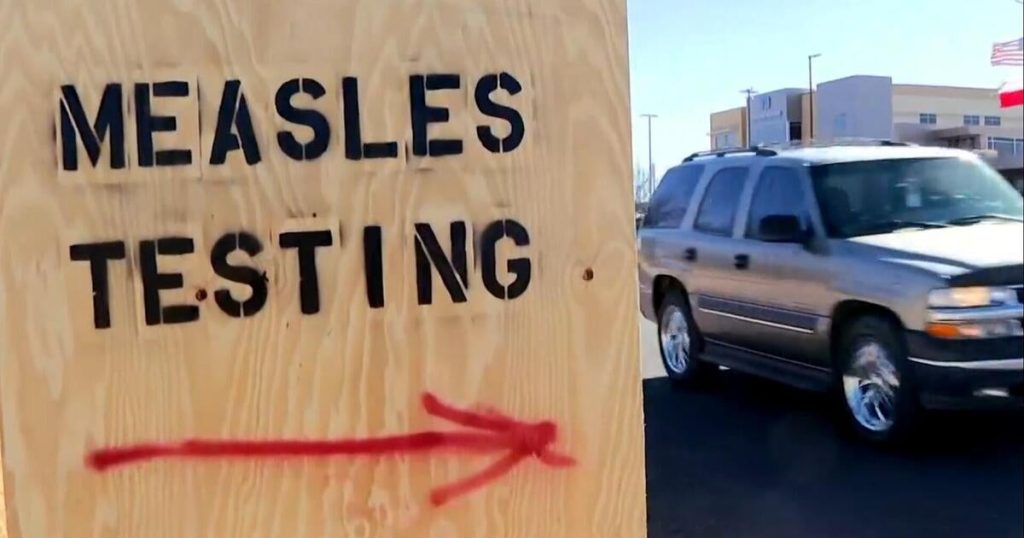Recent reports from the Centers for Disease Control and Prevention (CDC) reveal that the United States has recorded at least 308 measles cases in 2023, marking the highest infection total in a single year since 2019. The majority of these cases stem from a significant outbreak primarily affecting Texas and New Mexico, with at least 284 confirmed infections attributed to this crisis. As health officials express concern over the rising case numbers, additional focus is placed on the implications for public health on a national and international scale.
| Article Subheadings |
|---|
| 1) Overview of Current Measles Cases |
| 2) Historical Context of Measles Outbreaks |
| 3) Rising Health Concerns |
| 4) Global Context and Response |
| 5) Public Health Recommendations |
Overview of Current Measles Cases
As of recent reports by the CDC, the United States has documented at least 308 cases of measles in 2023 thus far. This figure not only highlights a resurgence of the disease but also surpasses the total of 285 cases reported throughout the entire previous year. The predominant outbreak is concentrated in Texas and its neighboring state, New Mexico, where the data indicate at least 284 of the total cases have been linked to this region. The increase in measles infections raises alarms among health officials, who are concerned about the risk of broader outbreaks if vaccination rates do not improve.
Historical Context of Measles Outbreaks
To understand the current situation, it is essential to consider the history of measles outbreaks in the U.S. The record for the most cases in recent years was set in 2019, marking a troubling year with a total of 1,274 reported cases. The CDC noted that previous outbreaks were frequently associated with communities that had low vaccination rates, particularly in New York. In assessing the current outbreak’s context against these historical benchmarks, it becomes apparent that the reemergence of measles is closely tied to the vaccination landscape and compliance within communities.
Rising Health Concerns
In addition to the rising case numbers, there are notable health concerns arising from the ongoing outbreaks. This year marks a grim point, as it produced the first measles-related death in the U.S. since 2019 when a child hospitalized with the virus passed away in West Texas. Furthermore, a recent case involved an unvaccinated adult in New Mexico who tested positive for measles after their death, currently under investigation regarding the official cause of fatality. These developments underscore the potential severity of measles and its implications, particularly for vulnerable segments of the population.
Global Context and Response
The rise in measles cases is not confined to the United States; other countries are experiencing similar trends. Canada is currently facing a significant outbreak that has contributed to increasing case numbers across the Americas. The World Health Organization (WHO) recently voiced its concerns, noting that the elimination status of measles in the region is at risk. Health officials in Europe and Asia have also reported rising numbers of infections, drawing attention to the global need for heightened immunization efforts during a time when gaps in vaccination coverage are prevalent.
Public Health Recommendations
In response to these alarming trends, the CDC has issued health advisories aimed at encouraging Americans to ensure they are fully vaccinated against measles, particularly ahead of the upcoming travel season. Awareness campaigns focus on the importance of vaccination, emphasizing that unvaccinated individuals remain at the highest risk for contracting and spreading the disease. Additionally, while most cases this year have been linked to unvaccinated or undervaccinated individuals who encountered the virus through international travel, states including Maryland, New York, and Vermont have recently reported cases, adding further gravity to the national health crisis.
| No. | Key Points |
|---|---|
| 1 | The U.S. has reported 308 measles cases in 2023, surpassing last year’s total. |
| 2 | Majority of cases are linked to outbreaks in Texas and New Mexico. |
| 3 | The last measles-related death occurred earlier this year in Texas. |
| 4 | Global outbreaks in Canada and other regions raise significant health concerns. |
| 5 | CDC urges vaccinations, especially for travelers and underserved communities. |
Summary
The reemergence of measles in the United States, reflected in the alarming case numbers reported by the CDC, serves as a critical reminder of the importance of vaccination. With significant outbreaks primarily in Texas and New Mexico, coupled with cases surfacing in other states, health officials find themselves on high alert. The global context points to a broader trend, reinforcing the need for continual advocacy and public health initiatives to protect communities from the resurgence of preventable diseases.
Frequently Asked Questions
Question: What causes measles outbreaks?
Measles outbreaks typically occur when there is a significant number of unvaccinated or undervaccinated individuals in a community. The virus spreads easily among people, especially those who have not been vaccinated.
Question: How effective are measles vaccinations?
Vaccinations for measles are highly effective, providing around 93% immunity after the first dose and around 97% immunity after the second dose, which is why maintaining high vaccination rates is crucial for community protection.
Question: What should I do if I am traveling during an outbreak?
If you are planning to travel during a measles outbreak, it is essential to ensure you are up-to-date on your measles vaccinations. Consult with a healthcare professional for any additional recommendations to protect yourself and others.


